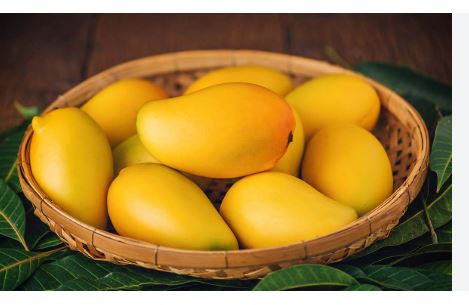
Alphonso mangoes belong to the species Mangifera indica, a member of the Anacardiaceae family, which also includes cashews and pistachios. This evergreen tree is native to South Asia, particularly the Indian subcontinent, where it has been cultivated for thousands of years. The Alphonso cultivar, known scientifically as Mangifera indica ‘Alphonso,’ is a specific variety prized for its unique qualities.
The Alphonso mango traces its roots to western India, specifically the Konkan region of Maharashtra. It’s believed to have been introduced or refined in the 16th century during Portuguese colonization, possibly named after Afonso de Albuquerque, a Portuguese general and governor who helped establish colonial presence in India. While the exact origin story is debated, this cultivar has been perfected over centuries by local farmers, particularly in the towns of Ratnagiri and Devgad. By the 19th and 20th centuries, its reputation spread globally, earning it a loyal following and export status. Today, India remains the primary producer, with strict geographical indications (GI) protecting authentic Alphonso mangoes from these regions.
Alphonso mangoes are medium-sized, typically weighing 8–12 ounces (225–340 grams), with an oval or kidney-shaped form. Their skin starts green and ripens to a golden-yellow hue, often with a slight reddish blush, though it’s not as vibrant as some other varieties. The flesh is a deep saffron-orange, smooth, and fiber-free, setting it apart from stringier mango cultivars. The fruit is juicy and creamy, with a thin, edible seed that maximizes the edible portion. The tree itself thrives in tropical climates, reaching heights of 30–100 feet (9–30 meters) if unpruned, though commercial orchards keep them shorter for easier harvesting.
The taste of an Alphonso mango is what elevates it to legendary status. It’s intensely sweet with a rich, honeyed flavor, balanced by subtle tart undertones that keep it from being cloying. There’s a floral, almost resinous quality—sometimes likened to a mix of peach, apricot, and citrus—followed by a velvety, buttery finish. This complexity makes it a favorite for eating fresh, blending into smoothies, or using in desserts like mango lassi or ice cream. Connoisseurs often note its lingering aftertaste, which is both refreshing and indulgent.
Alphonso mango trees are tropical by nature and thrive best in USDA Hardiness Zones 10–11. They need warm, humid conditions with temperatures consistently above 40°F (4°C) to avoid damage, though they prefer a range of 70–95°F (21–35°C) for optimal growth and fruiting. A distinct dry season followed by monsoon-like rains mimics their native environment, triggering flowering and fruit development. In the U.S., they can be grown in parts of Florida, Southern California, and Hawaii, but frost is a dealbreaker—anything below freezing can kill young trees or ruin a season’s crop. Home growers outside these zones often use greenhouses or containers to protect them.
Culnary Applications of Alphonso mango
- Fresh Eating: Peeled and sliced, their creamy, fiber-free flesh is a luxurious treat on its own, bursting with tropical flavor.
- Smoothies: Blended with yogurt or milk, Alphonso mangoes create a silky, naturally sweet drink—think mango lassi perfection.
- Desserts: Pureed into ice creams, sorbets, or mousses, they deliver a vibrant saffron hue and honeyed taste.
- Salsas: Diced with chili, lime, and cilantro, they add a sweet-spicy kick to fish tacos or grilled chicken.
- Chutneys: Cooked with spices like cumin or mustard seeds, their floral sweetness balances tangy, savory spreads.
- Cakes: Folded into batters or layered in upside-down cakes, Alphonso chunks bring moisture and a fruity depth.
- Cocktails: Muddled into mojitos or blended for daiquiris, they infuse drinks with a lush, summery vibe.
Cultivation of Alphonso mangoes
- Climate: Alphonso mangoes thrive in tropical climates with warm temperatures (70–95°F or 21–35°C) and a distinct dry season followed by humidity to trigger flowering.
- Soil: Well-drained, loamy or sandy loam soils with a pH of 5.5–7.5 are ideal, ensuring roots aren’t waterlogged.
- Propagation: Grafting is the preferred method, typically onto hardy rootstocks like ‘Totapuri,’ to maintain the Alphonso’s true traits and speed up fruiting.
- Planting: Trees are spaced 25–30 feet (7.5–9 meters) apart in orchards, planted during the monsoon for root establishment.
- Watering: Young trees need regular irrigation, while mature ones rely on seasonal rains, with minimal watering during the dry flowering phase.
- Pruning: Light pruning after harvest shapes the canopy, removes dead wood, and encourages next season’s growth.
- Flowering: Induced by a dry spell (2–3 months), flowering starts in late winter to early spring, with pollination aided by bees and flies.
- Fruiting: Fruits mature in 100–120 days post-flowering, ripening from April to June in India’s prime regions.
- Pest Management: Common threats like fruit flies, hoppers, and anthracnose are managed with organic neem sprays or targeted pesticides.
- Fertilization: Balanced applications of nitrogen, phosphorus, and potassium, plus micronutrients like zinc, support healthy yields.
- Harvesting: Fruits are hand-picked when mature but green, allowing them to ripen off the tree for better flavor and shelf life.
- Yield: A mature tree (10+ years) can produce 100–200 mangoes annually, though biennial bearing—alternating heavy and light years—is common.